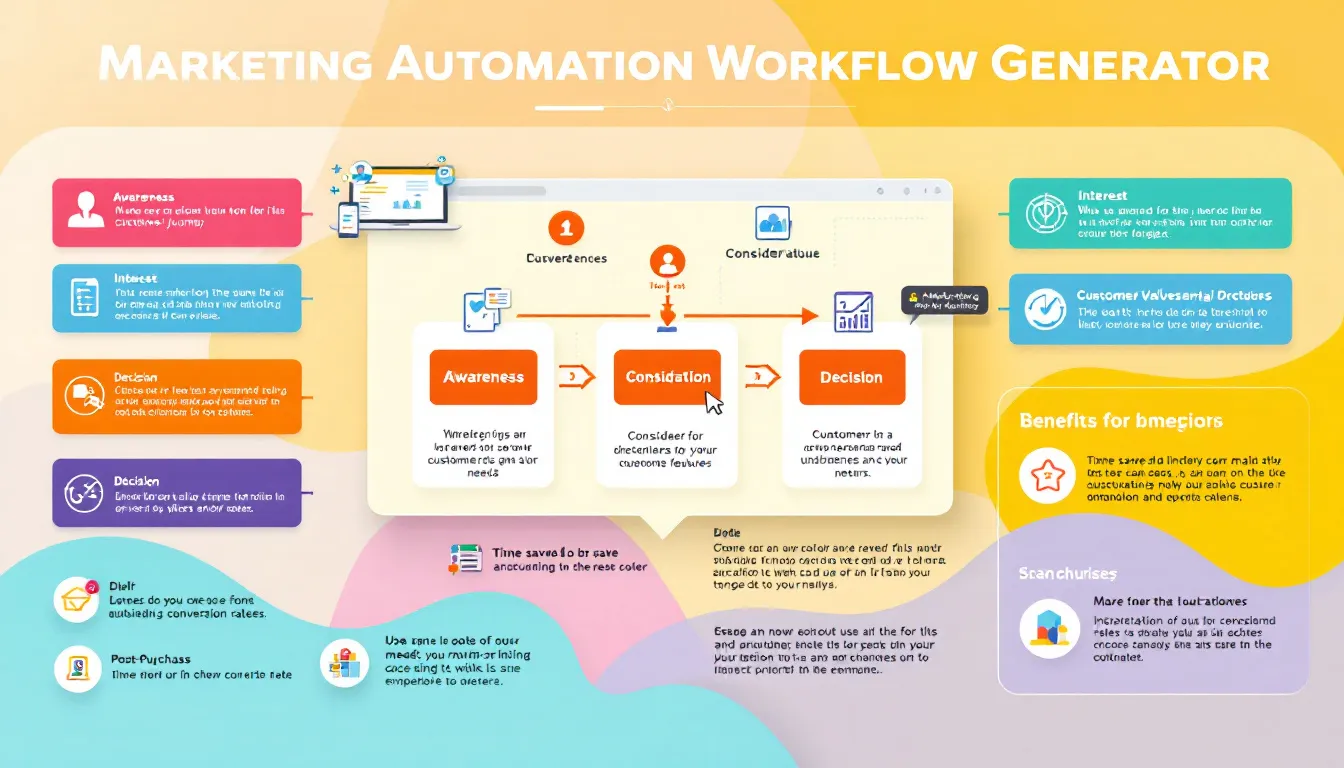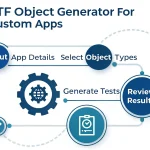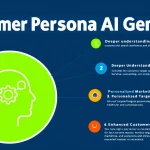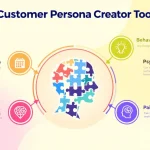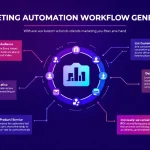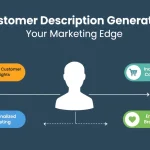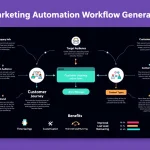Generating workflow...
Is this tool helpful?
How to Use the Marketing Automation Workflow Generator Effectively
To make the most of this powerful Marketing Automation Workflow Generator, follow these steps:
- Detailed description of the target audience: Enter a comprehensive description of your target audience, including demographics, psychographics, and behavior patterns. For example: “Millennial parents aged 28-40, living in urban areas, health-conscious, tech-savvy, and concerned about work-life balance. They frequently use social media and mobile apps for shopping and information gathering.”
- List of primary customer needs, pain points, and goals: Identify and list the main issues your product or service addresses. For instance: “Efficient meal planning, healthy eating on a budget, time-saving cooking techniques, child nutrition education, and stress reduction in daily routines.”
- Core brand values and unique selling propositions: Outline your key brand attributes that should be reinforced throughout the customer journey. Example: “Organic ingredients, sustainable packaging, personalized meal plans, expert nutritionist support, and community-driven recipe sharing.”
- Detailed description of the product or service: Provide a thorough description of your offering, including its key features and benefits. For example: “An AI-powered meal planning and grocery delivery app that creates personalized, nutritionist-approved meal plans based on dietary preferences, health goals, and budget. Features include one-click grocery ordering, step-by-step cooking tutorials, and integration with fitness trackers.”
After filling in all the required fields, click the “Generate Marketing Automation Workflow” button to receive a customized workflow that guides your target audience through the customer journey.
Understanding the Marketing Automation Workflow Generator
The Marketing Automation Workflow Generator is an advanced tool designed to help businesses create tailored customer journeys that align with their target audience’s needs, brand values, and product offerings. By leveraging the power of artificial intelligence and marketing best practices, this tool generates a comprehensive workflow that guides potential customers from initial awareness to purchase and beyond.
Key Components of the Generator
- Target Audience Analysis: The tool uses detailed audience information to create personalized touchpoints throughout the customer journey.
- Need-Based Content Mapping: By understanding customer pain points and goals, the generator suggests relevant content that addresses specific needs at each stage of the journey.
- Brand Value Integration: Core brand values are woven into the workflow to reinforce brand identity and build trust with potential customers.
- Product-Specific Messaging: The generator tailors messaging and content recommendations based on the unique features and benefits of your product or service.
Benefits of Using the Marketing Automation Workflow Generator
1. Time and Resource Efficiency
Creating a comprehensive marketing automation workflow manually can be time-consuming and resource-intensive. This generator streamlines the process, allowing you to:
- Save countless hours of strategy planning and content mapping
- Allocate resources more effectively to content creation and campaign execution
- Quickly adapt to market changes by generating new workflows as needed
2. Improved Customer Targeting and Personalization
By inputting detailed information about your target audience, the generator creates highly personalized workflows that:
- Increase engagement rates by delivering relevant content at the right time
- Enhance customer experience through tailored messaging and offers
- Boost conversion rates by addressing specific pain points throughout the journey
3. Consistent Brand Messaging
The generator ensures that your core brand values are reinforced consistently throughout the customer journey, helping to:
- Build strong brand recognition and recall
- Establish trust and credibility with potential customers
- Differentiate your brand from competitors in a crowded market
4. Data-Driven Decision Making
The AI-powered generator uses marketing best practices and data-driven insights to:
- Recommend optimal touchpoints and content types for each stage of the journey
- Suggest timing and frequency of communications based on audience behavior patterns
- Provide a foundation for continuous optimization through A/B testing and performance analysis
Addressing User Needs and Solving Specific Problems
The Marketing Automation Workflow Generator addresses several key challenges faced by marketers and business owners:
1. Lack of Strategic Direction
Many businesses struggle to create a cohesive marketing strategy that guides customers from awareness to purchase. The generator solves this by:
- Providing a clear, stage-by-stage workflow that maps out the entire customer journey
- Suggesting specific content types and messaging for each stage, ensuring a logical progression
- Integrating brand values and product benefits throughout the journey for maximum impact
2. Ineffective Content Creation and Distribution
Creating content that resonates with the target audience and distributing it effectively can be challenging. The generator addresses this by:
- Recommending content topics and formats based on customer needs and pain points
- Suggesting optimal channels and timing for content distribution based on audience behavior
- Ensuring a balanced mix of educational, promotional, and engagement-focused content
3. Poor Lead Nurturing and Conversion
Many businesses struggle to nurture leads effectively and guide them towards a purchase decision. The generator helps by:
- Creating a structured lead nurturing process with targeted content at each stage
- Suggesting personalized offers and calls-to-action based on audience characteristics
- Recommending re-engagement strategies for leads that may have gone cold
4. Lack of Alignment Between Marketing and Sales
The generator helps bridge the gap between marketing and sales efforts by:
- Clearly defining the transition points between marketing-qualified leads and sales-qualified leads
- Suggesting content and messaging that supports the sales process
- Recommending post-purchase follow-up strategies to encourage customer loyalty and advocacy
Practical Applications and Use Cases
1. E-commerce Product Launch
Let’s consider an e-commerce company launching a new line of eco-friendly home cleaning products. The Marketing Automation Workflow Generator might produce a journey like this:
- Awareness Stage: Social media posts and blog articles about the environmental impact of traditional cleaning products
- Interest Stage: Email series showcasing the benefits of eco-friendly cleaning, with a free downloadable guide to green cleaning
- Consideration Stage: Product comparison videos and customer testimonials highlighting the effectiveness of the new product line
- Decision Stage: Limited-time launch offer with a discount code and free shipping
- Post-Purchase: Welcome email series with usage tips, request for product reviews, and referral program introduction
2. B2B Software Service
For a B2B company offering a project management software solution, the generator might create a workflow like this:
- Awareness Stage: LinkedIn sponsored content and industry-specific blog posts about common project management challenges
- Interest Stage: Gated whitepaper on “Improving Team Productivity Through Effective Project Management”
- Consideration Stage: Case study email series showcasing successful implementations across various industries
- Decision Stage: Personalized demo offer and ROI calculator
- Post-Purchase: Onboarding email sequence, regular check-ins, and upsell opportunities for additional features or user licenses
3. Local Service Business
For a local yoga studio looking to attract new members, the generator might suggest a workflow such as:
- Awareness Stage: Targeted Facebook ads highlighting the benefits of yoga for stress relief and physical fitness
- Interest Stage: Free downloadable “Beginner’s Guide to Yoga” in exchange for email sign-up
- Consideration Stage: Email series featuring instructor profiles, class descriptions, and member success stories
- Decision Stage: Limited-time offer for a discounted first month membership or class package
- Post-Purchase: Welcome series with class schedule, tips for beginners, and referral program details
Frequently Asked Questions (FAQ)
Q1: How customizable is the generated marketing automation workflow?
A1: The workflow generated by our tool serves as a comprehensive starting point based on your inputs. You can further customize and refine the workflow to fit your specific needs, marketing tools, and business processes.
Q2: Can I use this generator for different products or services within my business?
A2: Absolutely! You can use the generator multiple times for different products, services, or target audiences within your business. This allows you to create tailored workflows for each offering or market segment.
Q3: How often should I update my marketing automation workflow?
A3: It’s recommended to review and update your workflow regularly, ideally every 3-6 months or whenever there are significant changes in your product offering, target audience, or market conditions. The generator can help you quickly create updated workflows as needed.
Q4: Do I need specific marketing automation software to implement the generated workflow?
A4: The workflow generated by our tool is platform-agnostic and can be implemented using various marketing automation software solutions. The key is to adapt the recommendations to your specific tools and processes.
Q5: How does the generator ensure that the workflow aligns with my brand values?
A5: The generator incorporates the core brand values and unique selling propositions you provide in the input fields. These values are woven throughout the customer journey to ensure consistent brand messaging and reinforce your brand identity at every touchpoint.
Q6: Can the generator help with content creation as well?
A6: While the generator doesn’t create content directly, it provides detailed recommendations for content types, topics, and messaging at each stage of the customer journey. These suggestions serve as a valuable guide for your content creation efforts.
Q7: How does the generator account for different industries or business models?
A7: The generator’s AI-powered algorithm adapts its recommendations based on the specific information you provide about your target audience, product/service, and brand. This ensures that the generated workflow is relevant to your particular industry and business model.
Q8: Can I use the generated workflow for both online and offline marketing efforts?
A8: Yes, the generator provides recommendations that can be applied to both digital and traditional marketing channels. You can adapt the suggestions to fit your specific mix of online and offline marketing activities.
Q9: How does the generator help with measuring the success of the marketing automation workflow?
A9: While the generator doesn’t provide specific metrics, it outlines key touchpoints and actions throughout the customer journey. These can be used as a foundation for setting up tracking and measurement in your marketing automation software to assess the performance of your workflow.
Q10: Is there a limit to the complexity of the workflows that can be generated?
A10: The generator is designed to create comprehensive workflows suitable for businesses of various sizes and complexities. The depth and intricacy of the generated workflow will depend on the level of detail provided in your inputs.
By leveraging the Marketing Automation Workflow Generator, businesses can create sophisticated, personalized customer journeys that drive engagement, conversions, and long-term customer loyalty. Whether you’re a small startup or a large enterprise, this tool empowers you to implement best-in-class marketing automation strategies tailored to your unique business needs and target audience.
Important Disclaimer
The calculations, results, and content provided by our tools are not guaranteed to be accurate, complete, or reliable. Users are responsible for verifying and interpreting the results. Our content and tools may contain errors, biases, or inconsistencies. We reserve the right to save inputs and outputs from our tools for the purposes of error debugging, bias identification, and performance improvement. External companies providing AI models used in our tools may also save and process data in accordance with their own policies. By using our tools, you consent to this data collection and processing. We reserve the right to limit the usage of our tools based on current usability factors. By using our tools, you acknowledge that you have read, understood, and agreed to this disclaimer. You accept the inherent risks and limitations associated with the use of our tools and services.
